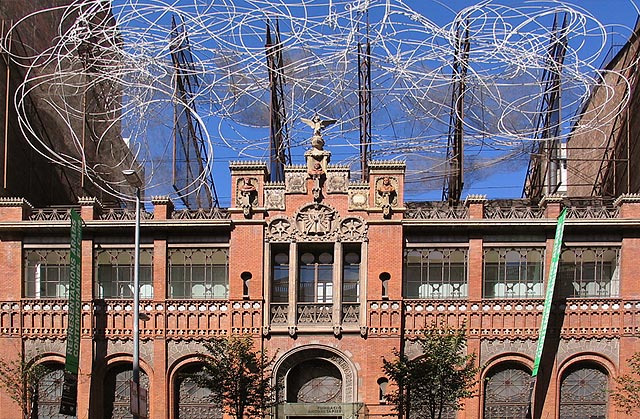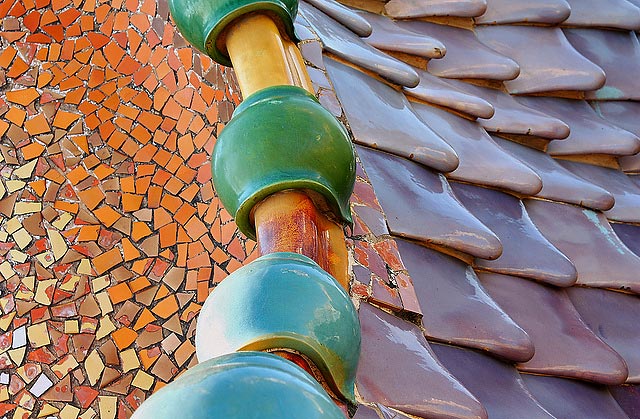What is Modernisme? How does it relate to Gaudí and Barcelona? Let me give you some handy background information on this wonderful Art movement that revolutionised the face of the city.
When I was a humble Art student many years ago, our final year trip was planned for Barcelona. Three things sprung to mind: sun (I am from Ireland), the Olympics (which had been recently hosted there) and Gaudí. The 1992 Olympic Games put this city on the map and Gaudí’s buildings got free advertising to the masses, promoting him even more into one of the most iconic architects in Europe. His buildings are eye catching and imaginative. Curves, sculptural iron work, ceramic mosaics and stone sculptures adorn his buildings, making them very pleasing to the eye. Genius as he was, these features were not unique to his works. He was part of an exciting Art movement that was progressing with lightning speed throughout Europe. In England they named this style Art Nouveau, the French ironically called it Le Style Moderne, in Germany it was the Jugenstil, Sezession for the Viennese and Modernisme here in Catalonia.
19th century architecture had been quite eclectic. It borrowed bits and pieces from past styles and reworked them a little. From this was forged the fantastically beautiful Art Nouveau. Common features were fluid lines inspired by nature, stunning incorporation of craft work and idealisation of the past.

Editorial Montaner i Simon, a printing house commissioned in 1879, kicked off the Modernisme movement here in Barcelona. Instead of a stone façade, red bricks were used combined with iron and clay sculptural details. Constructing with ordinary cheap materials were unheard of for such a grand structure at the time. This building started the trend. Skilfully worked metal and ceramic became common decorations. The simple craft man rose in status to be on equal terms with the architect. He was now the designer, making one off pieces to suit the theme of the building. A fantastic place to see amazing hand made furniture and ornaments of this style is the Modernisme Museum, just around the corner from this building.
As the movement gathered momentum, more Gothic style abodes appeared. Turrets, crenulations, arched windows and gargoyles were common sights in the new neighbourhoods. This reflected Catalonia’s powerful medieval period before the formation of Spain. The past was being romanticised. Men sported bushy beards, women wore long flowing dresses and their long hair was loosely swept up. There was a revival of the Catalan language and traditions. Sculptures of a dashing Saint George (their patron saint) killing a dragon and saving the princess were everywhere. Country life was idealised, curling plants and pretty flowers were carved and painted onto the buildings. Sea, commerce, industry and agriculture were 4 images that reflected the mighty city. You can see symbols of them all over Barcelona. The urban landscape was out of control, cluttered with over the top apartment blocks. This might explain the very short lifespan of this particular Art style (1890-1915). People quickly got sick of it and architecture reverted to plainer, more classical designs.

If you are interested in seeing part of this rich heritage, visit the Eixample. It coincided with the new trend so this neighbourhood has one of the highest concentration of urban Art Nouveau buildings in the world. A lot of the rich bourgeois were responsible for commissioning these creations. One must not forget, however, that alongside all this wealth was vast poverty. Some working-class people did not have time or appreciation for the new indulgent fad. There is a darker social aspect to this era which will definitely be explored in a later post.
Photographs by Wenjie, Zhang and Tobias Steinhoff











Curves, sculptural iron work, ceramic mosaics and stone sculptures. Love how you describe Gaudi’s work and the history of Modernisme. I also read somewhere that Catalan architecture during this period was inspired by Spain’s Moorish (Muslim) past. Not sure if that’s true but it’s certainly interesting!
I learned a ton from this article, but I do want to make one correction! The Montaner i Simon building you describe and picture in fact houses the Tapies Foundation, not the Modernisme Museum, which is around the corner in a much plainer building.
Also, wanted to give you a heads up that a lot of these sites are offering half-off entry until September 15. There are 20 places in total included in the promo, including Fundació Antoni Tàpies, La Pedrera, and Casa Amatller. All you need to do is sign up for emails from Ajuntament de Barcelona, print the discount booklet, and present the page at the ticket counter.
Plus, Sagrada Familia is offering a rare discount as well. Until the end of September under 30s can get in on certain evenings for 50% off any ticket package.
Learn more: https://www.citypassproject.com/tips/unbeatable-discounts-gaudi/
Thanks for the info Nicole. The 50% discount program is fantastic and a great oprtunity to enjoy some of these wonderful masterpieces.
About the Moorish influence, the architects of the Modernisme movement got inspiration from a lot of different sources and the Islamic architecture was definitely a very important one. You just have to take a look at Casa Vicens to see this.
The Modernisme Museum and Tapies Foundation are completely different buildings. I think that you misunderstood the text. I’ll try to phrase it in a different way to avoid misunderstandings.